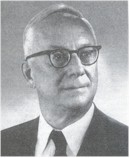E. Leon Chaffee
E. Leon Chaffee: Biography
Born: 15 April 1885
Died: 8 March 1975
E. Leon Chaffee was born in Somerville, Mass. on 15 April 1885. He received the B.S. degree in electrical engineering in 1907 from the Massachusetts Institute of Technology. He then attended the Graduate School of Arts and Sciences at Harvard University where he received the M.S. degree in physics in 1908 and the Ph.D. degree in physics in 1911.
In 1910, during his doctoral research, Chaffee discovered a method of producing the first coherent continuous electrical oscillations from 1 to 100 or more megacycles and applied them to radiotelephony. For this work he was awarded the Bowdoin Prize at Harvard and the Longstretch Medal of Merit of the Franklin Institute.
He remained on the faculty of Harvard University until his retirement in 1953. Appointed instructor in electrical engineering in 1911, he progressed to Assistant Professor of Physics in 1917, Associate Professor of Physics in 1923, and Professor of Physics in 1926. He was appointed as Rumford Professor of Physics in 1940, and Gordon McKay Professor of Applied Physics in 1946. These last two appointments were continued as emeritus professorships after retirement.
His work also had concrete practical applications. In the 1920s, he had airplanes release charged grains of sand to disperse clouds over Washington, demonstrating weather control. During World War II, he directed research that led to better radar equipment and led a Harvard program that trained soldiers in electronics.
During his forty-two years of active research, Chaffee served as Director of from Cruft Laboratory from 1940, Co-director of the Lyman Laboratory of Physics from 1947, Chairman of the Department of Engineering Sciences and Applied Physics 1949-52, and head of wartime Pre-Radar Training Course for Officers of the three services.
He was awarded the honorary degrees of Doctor of Science from Harvard in 1944, and Doctor of Engineering from Case Institute of Technology in 1955. An early researcher in the theory of vacuum tubes, he published many papers in electronics, physics, and biophysics. He was author of two books and co-author of another.
Dr. Chaffee served as Vice-President of the IRE in 1922. He was Fellow of the American Academy of Arts and Sciences, the American Physical Society, and the IRE, and member of Tau Beta Pi and Sigma Xi. He was awarded the IEEE Medal of Honor in 1959, "For his outstanding research contributions and his dedication to training for leadership in radio engineering."
He died on 8 March 1975.
